
계절관리제 기간 수도권 경유차 배출에 의한 PM2.5 농도 영향
 ; Eunhye Kim1)
; Eunhye Kim1) ; Yoon-Hee Kang
; Yoon-Hee Kang ; Seunghee You2)
; Seunghee You2) ; Minah Bae2)
; Minah Bae2) ; Kyuwon Son2)
; Kyuwon Son2) ; Soontae Kim1), *
; Soontae Kim1), *
Abstract
The impact of diesel vehicle emissions which accounts for a 90% of the on-road mobile NOX emissions in the Seoul Metropolitan Area (SMA) on PM2.5 concentration was estimated by the brute force method with the Community Multiscale Air Quality (CMAQ) model during the seasonal PM2.5 management from December 2019 to March 2020. The period mean impact of the SMA diesel vehicle emissions on the PM2.5 concentration was 0.8 μg/m3 over the SMA during the simulation period, which was led by organic carbon (OC, 0.4 μg/m3) and primary PM2.5 (0.4 μg/m3) rather than nitrate (0.0 μg/m3) formed from NOX. When the impact of NOX emissions from the diesel vehicle to the monthly mean nitrate was evaluated, the negative impact, so-called ‘NOX-disbenefit’, in which NOX reductions increased nitrate formation appeared in December 2019 (-0.5 μg/m3) and January 2020 (-0.1 μg/m3). An alternative air quality simulation with an additional 50% reduction of NOX emissions from all the emission sources except the on-road mobile greatly reduced the NOX-disbenefit effect. As a result, the NOX-reduced condition increased the overall impact of the SMA diesel vehicle emissions on PM2.5 and nitrate over the region by up to 1.3 μg/m3 and 0.5 μg/m3, respectively. It implies that even the same emission control may exhibit different effectiveness in the PM2.5 change depending on the NOX conditions. Thus, it is necessary to better understand how the non-linearity of the secondary PM2.5 formation plays a role in determining the overall impact of emission abatement plans to improve air quality over a region.
Keywords:
Seasonal PM2.5 management, Diesel vehicle emissions, NOX-disbenefit, NOX-to-nitrate conversion, Control effectiveness1. 서 론
PM2.5 (Particulate matter of which diameter is less than 2.5 μm)는 건강에 미치는 악영향으로 인해 (Jung et al., 2020; Lee et al., 2020; Schlesinger, 2007), 국내를 비롯한 동아시아 지역에서 최근 심각한 사회 문제로 인식되고 있다 (Ghim et al., 2019; Kwon et al., 2016; Shin, 2013; Heo et al., 2009). 이에 중국에서는 PM2.5 농도 저감을 위해 화력발전과 교통 등 주요 오염원을 대상으로 PM2.5의 전구물질인 NOX, SOX 등의 배출 관리를 펼치고 있다 (Ding et al., 2019a; Ding et al., 2019b; Cai et al., 2018; Huo et al., 2015). 국내에서도 PM2.5에 대한 사회적 우려와 불편을 해소하고, 겨울철과 봄철에 주로 높아지는 PM2.5 농도에 대응하기 위해 2019년 12월부터 2020년 3월까지 대기오염물질 배출량이 많은 산업, 발전, 교통 등의 오염원에 대한 계절관리제를 시행하였다 (MOE, 2020).
경유차에서 배출되는 일부 성분들은 발암성을 내재하고 있는 것으로 보고되며 (Anenberg et al., 2017; Gentner et al., 2017; IARC Working Group on the Evaluation of Carcinogenic Risks to Humans, 2014), 내연기관의 연소 과정에서 배출되는 NOX는 2차적인 PM2.5 생성에 관여하는 것으로 알려져 있다 (Holland et al., 2016). 대기정책지원시스템 (Clean Air Policy Support System; CAPSS)의 2016년 대기오염물질 배출목록 (NIER, 2019)에 수록된 국내 NOX 배출량 (1,248.3 kiloton per year (KTPY)) 중 33%인 416.3 KTPY가 경유차에서 배출된다. 특히, 수도권 지역에서 경유차의 NOX 배출량은 156.8 KTPY로 수도권의 전체 NOX 배출량 중 48%를 차지한다. 이외에도 경유차의 primary PM2.5 (PPM2.5) 배출량은 3.2 KTPY로 수도권의 전체 PPM2.5 배출량의 20%를 차지하고 있다. 그러나, 실질적으로 계절관리제 기간 동안 경유차의 PM2.5 농도 영향이 얼마나 되는지 정량적으로 제시된 바 없다.
본 연구에서는 1차 계절관리제가 시행되었던 2019년 12월부터 2020년 3월 대해 수도권 경유차 배출량이 PM2.5 농도에 미치는 영향을 분석하였다. 이를 위해 광화학 대기질 모사 수행을 통해 대상 기간 동안 수도권 경유차 배출량 삭감에 의해 개선될 수 있는 PM2.5 농도 범위를 정량적으로 산정하였다. 또한, 수도권 경유차 배출에 의한 질산염 등 PM2.5 구성 성분의 월별 변화와 함께, 기상 및 NOX 조건이 PM2.5 농도에 미치는 영향을 분석하였다.
2. 연구 방법
2. 1 수도권 경유차 배출량
CAPSS 2016 배출목록에서 자동차와 관련된 배출량은 운행 과정에서 발생하는 배기가스 관련 배출량과, 타이어 마모 등으로 인한 도로 및 비도로 재비산 배출량으로 분류할 수 있다. 이러한 비산먼지 배출량에는 경유차에 의한 배출량도 포함되나, 현재 CAPSS 2016 배출목록에서 경유차에 의한 비산먼지 배출량을 별도로 구분하기 어렵다. 따라서 본 연구에서는 경유차 운행 중에 발생하는 배기가스 배출량만을 대상으로 분석하였다.
대상 지역은 경유차 등 도로이동오염원이 밀집되어 있는 수도권으로 설정하였다. 표 1은 CAPSS 2016 배출목록을 이용하여 우리나라와 수도권의 대기오염물질 배출량과 경유차의 대기오염물질 배출량을 비교한 것이다. 경유차에서 배출되는 주된 대기오염물질은 NOX와 PPM2.5인 것으로 나타났다. 경유차의 NOX 배출 비중은 우리나라 전체 (33.3%)보다 수도권 (48.1%)에서 더 높았으며, PPM2.5의 배출 비중 또한 우리나라 전체 (9.6%)보다 수도권 (20.1%)에서 더 높았다.

Air pollutant emissions in South Korea and the Seoul Metropolitan Area (SMA) based on CAPSS 2016.(unit: kilotons per year, KTPY)
2. 2 대기질 모사
대기질 모사는 남한을 포함한 9 km 수평 격자 해상도의 모사 영역에 대해 수행하고 수도권을 중심으로 분석하였다 (그림 1). 모사 영역의 경계조건은 27 km 수평 격자 해상도 영역의 모사결과를 둥지 격자화하여 이용하였다 (Kim et al., 2019; Kim et al., 2018).
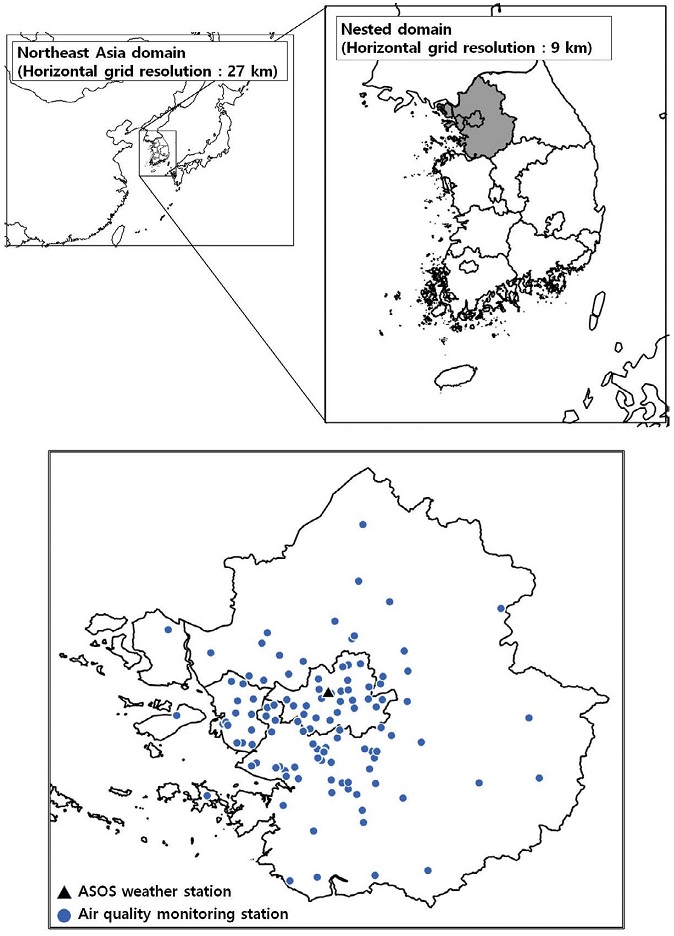
Modeling domains at horizontal grid resolutions of 27 km (top left) and nested 9 km (top right). The black triangle symbol shows the Automated Synoptic Observing System (ASOS) weather station in Seoul, and the blue circles represent the urban air quality monitoring stations in SMA.
분석기간은 1차 계절관리제 기간인 2019년 12월 1일부터 2020년 3월 31일까지로 설정하였으며, pre-run을 위해 이전 7일부터 모사를 개시하였다. 기상 입력자료는 NCEP-FNL (National Centers for Environmental Prediction-Final) 자료를 초기장으로 입력한 Weather Research and Forecasting (WRF; Skamarock and Klemp, 2008) v3.9.1을 이용하였고, Meteorology-Chemistry Interface Processor (MCIP) v3.6로 대기질 모델에 입력할 수 있는 형태로 변환하였다. 배출량 입력자료는 Sparse Matrix Operator Kernel Emissions (SMOKE) v3.1을 이용하여 처리하였으며 (Kim et al., 2008), 국내외 배출량 입력자료는 각각 CAPSS 2016와 Comprehensive Regional Emissions for Atmospheric Transport Experiment (CREATE)에 기반한 KORUS inventories version 5 (KORUS v5; Jang et al., 2019)를 사용하였다. 자연적인 배출량은 The Model of Emissions of Gases and Aerosols from Nature (MEGAN; Guenther et al., 2006)을 이용하여 산정하였다 (Kim et al., 2017a). 대기질 모사에는 Community Multiscale Air Quality (CMAQ; Byun and Schere, 2006) v4.7.1을 사용하였고, 표 1에 사용된 WRF와 CMAQ 모델의 세부 옵션을 정리하였다. 또한, 수도권 경유차 배출에 의한 PM2.5 농도 영향 분석 시 기상에 의한 영향을 검토하기 위하여 2018년 12월~2019년 3월을 대조 기간으로 동일한 모사를 수행하였다.
2. 3 민감도 모사 및 영향 분석
수도권 경유차 배출에 의한 PM2.5 농도 영향을 분석하기 위해서 기본 모사 외에 Brute Force Method (BFM) 기반의 민감도 모사를 수행하였다. BFM은 입력 자료의 변화에 따른 농도 변화를 분석하는 방법 중 하나이다 (Kim et al., 2019; Nam et al., 2019; Burr and Zhang, 2011). 본 연구에서는 수도권 경유차 배출량을 100% 감소시켜 배출 영향 (=기본 모사농도-민감도 모사농도)을 산정하였다.
한편, 계절관리제나 미세먼지 관리 종합계획 등으로 도로이동오염원 외에도 다른 오염원에 대한 배출량 관리가 이루어질 것으로 보인다. 이러한 종합적인 배출량 삭감은 수도권 등 대기오염물질의 배출밀도가 높은 지역의 NOX 풍부 또는 부족 조건을 변화시킬 수 있으며, 이로 인해 NOX-to-nitrate 전환이 달라질 수 있다 (Kim et al., 2017a; Kim et al., 2017b). 이에 본 연구에서는 CAPSS 2016 기반의 기본 조건 (Case 1) 외에, 도로이동오염원을 제외한 전국 모든 오염원의 NOX 배출량이 50% 삭감된 조건 (Case 2)을 설정하고, 각각의 조건에서 수도권 경유차 배출량 삭감 후 모사를 수행하여, NOX 조건에 따른 질산염 영향을 비교 분석하였다. 결과 분석 시 3.2~3.3절에서는 CAPSS 2016 기반의 모사결과를 논의하기 위하여 Case 1 모사만을 설명하였으며, 3.4절에서는 Case 1과 Case 2를 비교하여 변화된 NOX 농도 조건 하에서의 수도권 경유차 배출 영향을 논의하였다.
대기질 모사의 재현성은 도시대기측정망을 이용하여 평가하였으며, PM2.5 영향은 해당 측정소 위치 기반으로 분석하였다 (Bae et al., 2020b). PM2.5 성분은 황산염 (Sulfate), 질산염 (Nitrate), 암모늄 (Ammonium), 유기탄소 (Organic Carbon; OC), 그리고 기타성분 (Others)으로 분류하였다. 유기탄소의 경우 1차 유기탄소 (Primary Organic Compounds; POC)와 2차 유기탄소 (Secondary Organic Compounds; SOC)를 포함하며, 배출원에서 직접 배출되는 PPM2.5 성분 중원소탄소 (Elemental Carbon, EC)는 기타 성분으로 분류하였다.
3. 결과 분석
3. 1 기상 및 대기질 모사 수행평가
기상 모사의 수행평가를 위해 2019년 12월~2020년 3월에 대해 서울에 위치한 기상 측정소의 일평균 관측값과 모사값을 비교하였다 (그림 2). 기간 평균 2 m 관측기온은 3.3℃이었으며, 모사 기온은 3.4℃로 0.1℃ 차이를 보였다. 기간 평균 10 m 관측풍속은 2.3 m/s이고, 모사 풍속은 2.2 m/s로 관측풍속 대비 0.1 m/s 과소 모사되었다. 동기간 관측된 상대습도는 54.9%, 모사된 상대습도는 59.3%로 약 4.4% 과대 모사되었으며, 관측된 강수량은 1.2 mm, 모사된 강수량은 0.9 mm로, 0.3 mm 과소 모사되었다. 관측과 모사의 기온, 풍속, 상대습도, 강수량의 상관계수 (correlation coefficient)로서 R값은 각각 0.96, 0.89, 0.85, 0.96로 통계적으로 유의하였다. 대조 기간으로 모사된 2018년 12월~2019년 3월 사이에 대한 기상 수행평가는 그림 S1을 참고할 수 있다.
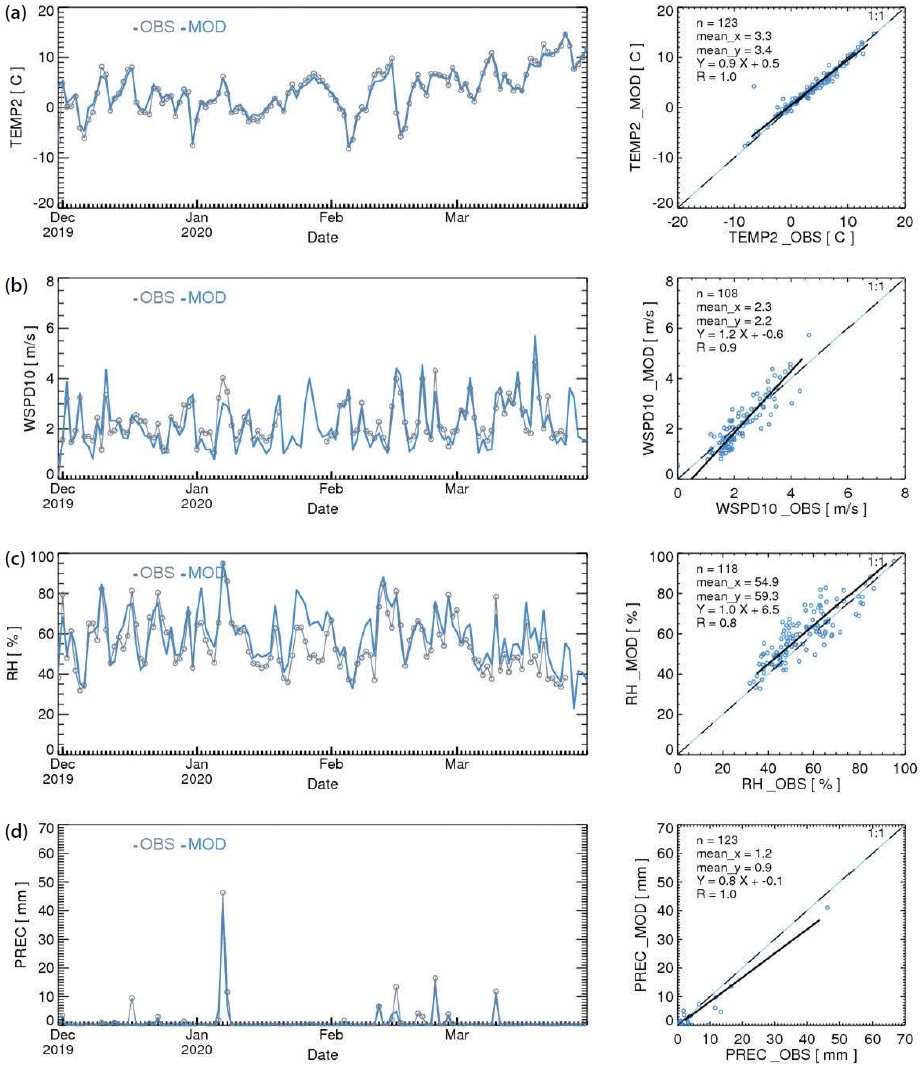
The time series and scatters of observed and simulated daily mean (a) 2-m temperature, (b) 10-m wind speed, (c) relative humidity, and (d) precipitation at the Seoul weather station during the simulation period of December 2019 to March 2020.
대기질 모사의 수행평가를 위해서는 수도권에 위치한 113개의 도시대기측정망에서 관측된 PM2.5, O3, NO2 및 SO2 농도와 모사농도를 비교하였다 (그림 3). 모사기간 동안 수도권의 일평균 PM2.5 관측농도는 24.1 μg/m3였고, 모사농도는 27.6 μg/m3으로, 관측농도 대비 3.6 μg/m3 과대 모사하였다 (그림 3(a) 참조). 일평균 O3, NO2, SO2 농도는 각각 관측농도 대비 2.1 ppb 과소 모사, 7.0 ppb 과대 모사, 0.2 ppb 과소 모사하였다 (표 4). 관측과 모사에서 일평균 PM2.5, O3, NO2, SO2 농도의 R값은 각각 0.75, 0.83, 0.89, 0.51였고, Normalized Mean Bias (NMB)는 각각 14.8%, -5.6%, 29.6%, -6.3%로 전반적으로 관측값과 통계적으로 유의하였다. 기상에 의한 수도권 경유차 배출 영향의 차이를 살펴보기 위해 수행된 이전 연도 기간 (2018년 12월~2019년 3월) 동안의 대기오염물질의 모사 수행평가는 그림 S2를 참고할 수 있다.
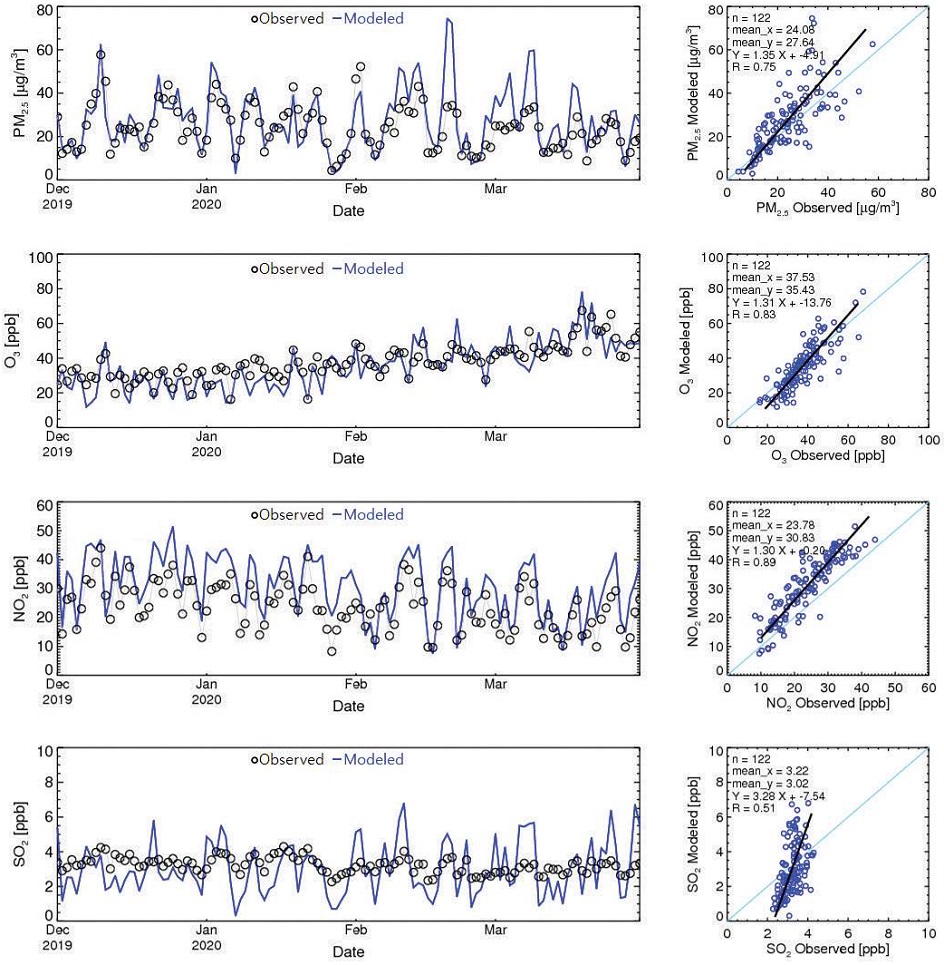
Time series and scatters of daily averages of the observed and simulated (a) PM2.5, (b) O3, (c) NO2, and (d) SO2 concentrations in the SMA from December 2019 to March 2020.
3. 2 계절관리제 기간 중 수도권 PM2.5 농도에 대한 수도권 경유차 배출 영향
그림 4는 2019년 12월부터 2020년 3월까지의 모사기간 평균 국내 PM2.5 농도에 대한 수도권 지역의 경유차 배출 영향을 보인 것이다. 수도권 경유차의 배출 영향은 배출 지역인 수도권을 중심으로 기간 평균 0.8 μg/m3 (기간 평균 PM2.5 모사농도의 2.7%)가량이었으며, 수도권의 풍하 지역인 강원에서는 기간 평균 0.6 μg/m3, 경북에서는 기간 평균 0.4 μg/m3의 PM2.5 농도 영향이 나타난다 (그림 4). 수도권의 배출 영향이 풍하 지역에서 나타나는 현상은 선행연구 (i.e., Yeo and Kim, 2019; Kim et al., 2017c)에서도 언급된 바 있다.
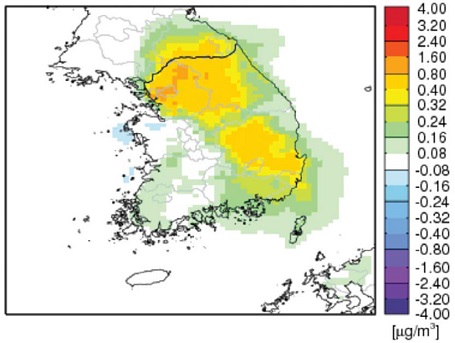
Impact of the SMA diesel vehicle emissions on the period mean PM2.5 concentration during the period of December 2019 to March 2020.
모사기간 동안 PM2.5 농도에 대한 수도권 경유차 배출 영향을 지자체별로 구분해보면, 서울에서는 1.0 μg/m3 (기간 평균 PM2.5 모사농도의 3.6%), 경기 0.7 μg/m3 (2.5%), 인천 0.6 μg/m3 (2.3%)로 지역별 차이를 보였다. 이는 PPM2.5 및 전구물질의 배출 밀도와 전구물질의 2차 PM2.5로의 전환율이 지역별로 다르기 때문인 것으로 파악된다 (Kim et al., 2021; Kim et al., 2017c). 이전 연도 (2018년 11월~2019년 3월)에 대한 모사에서도 수도권 경유차 배출에 의한 PM2.5 영향은 서울 1.0 μg/m3 (3.4%), 경기 0.6 μg/m3 (2.0%), 인천 0.5 μg/m3 (1.9%)으로 유사하게 나타났다 (그림 S3 참조). 이러한 PM2.5 중량농도 영향에 어떤 성분이 주요한지를 평가하기 위하여 수도권 경유차의 배출 영향을 PM2.5 성분별로 나눠 다음 절에서 살펴보았다.
3. 3 PM2.5 구성 성분별 영향
대기 중에서 2차적으로 생성되는 물질에 대한 수도권 경유차의 영향을 살펴보기 위하여 본 연구에서는 수도권 경유차에 의한 2차 생성물질 중 질산염은 NOX에 의해, 황산염은 SOX, 암모늄은 NH3로부터 생성되는 것으로 가정하였다. 유기탄소는 휘발성 유기화합물 (Volatile Organic Compounds; VOC)로부터의 2차 생성되는 SOC 외에 POC를 포함한다. 표 5는 모사기간 평균 PM2.5 중량 농도와 구성 성분별 영향을 지역별로 평균하여 제시한 것이다. 구성 성분별 농도에서 수도권 경유차 배출 영향은 유기탄소와 기타 성분에서 가장 높다. 기타 성분은 PPM2.5 배출량으로부터 화학종 분배되는 원소탄소, 1차 황산염, 1차 질산염 외에 알려지지 않은 성분 등을 포함한다.
한편, 경유차에서는 SOX가 거의 배출되지 않으므로 (표 1 참조) 황산염의 농도 영향은 매우 낮았다. NOX 배출에 의한 지역별 질산염 생성 영향 또한 모사기간 평균 동안 매우 낮거나 음의 영향이 나타났는데, 이와 같은 결과는 소위 NOX-disbenefit 효과에 의한 것으로 보인다. 일반적으로, 대기 중으로 배출된 NOX는 산화과정을 거쳐 HNO3, N2O5 등 중간물질로 전환된 후 물리화학적 반응을 통해 질산염으로 전환되는 것으로 알려져 있다 (Seinfeld and Pandis, 2016). 단, 수도권과 같이 NOX 배출이 풍부한 지역에서는 NOX 배출량의 감소가 O3에 대한 NO 적정 (titration) 감소로 이어져 O3 등 라디칼이 증가하게 된다. 이러한 라디칼의 증가는 NOX의 HNO3로의 산화를 촉진시켜 최종적으로는 질산염 농도를 높일 수 있다 (Kim et al., 2021; Huang et al., 2020; Li et al., 2018, Kim et al., 2017b, c). 따라서, 수도권 경유차의 NOX 배출량이 수도권 전체 NOX 배출량의 절반 (48%)가량을 차지함에도 불구하고, 모사기간 동안 PM2.5 농도에 대한 경유차 배출 감소 영향이 기대치보다 낮은 것으로 판단된다.
기존 국내외 연구에서도 이러한 NOX-disbenefit 영향이 보고된 바 있다 (Kim et al., 2021; Huang et al., 2020; Kim et al., 2017b). Huang et al. (2020)은 NOX 배출이 높은 중국 동부지역에서 2020년 초, COVID-19 발생에 따라 NOX 배출량이 크게 감소하면서 O3이나 NO3 (야간)과 같은 라디칼 농도가 증가하여 2차적으로 생성되는 PM이 증가함을 보고하였다. Kim et al. (2017c)은 고농도 PM2.5가 발생하는 추운 계절에 NOX 배출이 많은 수도권 지역을 중심으로 이러한 NOX-disbenefit 현상이 두드러지는 것으로 보고하였다.
이러한 NOX 배출량 변화에 따른 질산염 생성 변화는 Kim et al. (2017c)이 언급한 바와 같이 월별로 차이를 보일 수 있다. 그림 5로부터 CAPSS 2016 배출 목록에 기반한 Case 1 모사에서 수도권 경유차의 NOX 배출량 삭감 시, 2019년 12월과 2020년 1월에는 월평균 질산염 농도가 오히려 증가하며, 2020년 2월과 3월에는 월평균 질산염 농도가 감소하였다. 모사기간 동안 수도권 경유차의 NOX 배출량에 의한 월평균 질산염 농도 영향 범위는 -0.5 μg/m3~0.4 μg/m3 사이였다. 이처럼 계절관리 기간 중 PM2.5 농도에 대한 월별 NOX 배출 감소 영향이 음 (negative)과 양 (positive)의 방향에서 복합적으로 나타나, 전체 계절관리제 기간 동안 경유차 배출량의 감소 효과가 상쇄된 것으로 보인다.

Impacts of the SMA diesel vehicle emissions on the monthly mean PM2.5 components in (a) SMA, (b) Seoul, (c) Gyeonggi, and (d) Incheon during simulation period of December 2019 to March 2020.
그림 6에서 국내 모든 지역으로 확장하여 살펴보면, 수도권 지역 NOX 배출량 감소에 따른 질산염 농도 증가는 2019년 12월부터 2020년 1월까지 수도권을 중심으로 주 풍향 (서북서풍)에 따라 충남과 충북에서도 나타났다. 주목할 점은 수도권 경유차 전체 배출량에 의한 PM2.5 민감도와 NOX 배출량에 의한 질산염의 민감도가 시공간적으로 매우 유사한 월별 변화를 보인다는 것이다. 이는 수도권 경유차의 NOX 배출에 의한 질산염 생성 영향이 전반적인 PM2.5 중량농도 저감효과를 좌우할 수 있음을 의미한다. 질산염을 제외하면, 수도권 경유차 배출의 자체영향은 유기탄소와 1차 PM2.5를 포함하는 기타 성분에서 높게 나타난다. 황산염 농도에 대한 영향은 경유차에 의한 SOX 배출량이 매우 낮기 때문에 거의 나타나지 않는다. 월평균 암모늄의 시공간 분포는 질산염 농도의 변화와 유사하다.
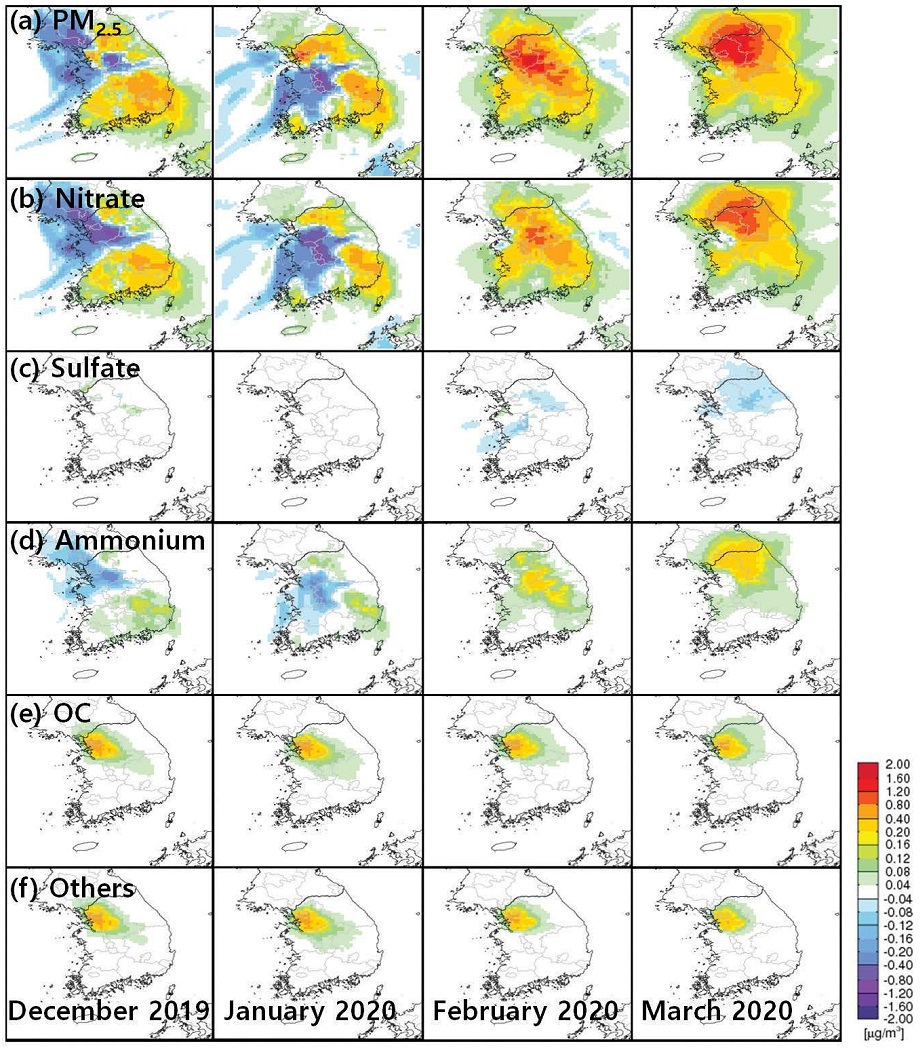
Impact of the SMA diesel vehicle emissions on monthly mean PM2.5 concentrations and its components during the simulation period of December 2019 to March 2020.
수도권의 풍하 지역인 강원에서는 월평균 0.2~1.0 μg/m3, 경북에서는 월평균 0.3~0.6 μg/m3의 PM2.5 농도 영향이 나타났는데, 풍하 지역에 대한 수도권 경유차 배출 영향은 질산염 등 2차 생성 물질의 영향에 의한 것으로 모사된다 (그림 6 참조). 이는 배출된 NOX 등 전구물질들이 풍하 지역으로 이동하면서 물리화학 과정을 통해 2차 PM2.5가 생성되었기 때문인 것으로 보인다.
한편, 기상 조건에 따른 저감 효과의 차이를 검토하기 위하여 그림 S4와 같이 1년 전 동기간 (2018년 12월~2019년 3월)에 대해 기상 입력자료만을 변경한 모사 결과를 제시하였다. Son et al. (2020)에 따르면, 2019년 12월부터 2020년 3월까지의 기상특성은 1년 전 동기간 대비 평균 기온이 1.5℃ 높았고, 강수량도 100 mm 증가하였다. 바람의 경우, 서풍이 최대 2 m/s가량 감소하면서 상대적으로 동풍의 빈도가 증가하였다. 그럼에도 불구하고 앞선 결과 (그림 6)와 동일하게 12월과 1월에는 수도권에서 NOX-disbenefit 효과가 뚜렷하게 나타났으며, 2월과 3월에는 NOX를 비롯한 수도권 경유차 배출량 감소가 PM2.5 농도 감소로 이어졌다.
3. 4 NOX 조건에 따른 수도권 경유차의 배출 영향
계절관리제에서는 도로이동오염원 이외에도 산업, 발전 등 다양한 부문에 걸친 포괄적인 대기오염물질 배출량 저감 계획을 목표한다. 이에 따른 타 배출원의 NOX 배출량 감소는 수도권을 비롯한 풍하 지역의 NOX 조건을 변화시키며, 이로 인해 앞선 언급된 NOX-disbenefit 효과도 달라질 것으로 판단된다. 이에 본 연구에서는 그림 7과 같이 서로 다른 NOX 조건에서의 수도권 경유차 배출에 의한 PM2.5 농도 영향을 비교하였다. 그림 7에서 Case 1의 기본 모사는 CAPSS 2016 기반 배출량을 그대로 적용한 경우이며, Case 2의 기본 모사는 전국적인 NOX 농도 조건 변화와 실험의 간편성을 위해서 전국 도로이동오염원 외 모든 NOX 배출량 50% 감소를 가정하였다. Case 2의 기본 모사 (BASE2)에서 국내 전체와 수도권의 NOX 배출량은 각각 850.7 KTPY, 250.6 KTPY로 Case 1의 기본 모사 (BASE1; 1248.3 KTPY, 326.1 KTPY)에 이용된 배출량 대비 각각 31.9%, 23.2% 낮다. 각각의 기본 모사에서 수도권 경유차의 NOX 배출량을 제외하면 수도권의 NOX 배출량은 169.2 KTPY (SENS1), 93.7 KTPY (SENS2)이 되며, 이는 Case 1의 기본 모사 대비 51.9%, 28.7% 수준이다.
그림 8을 보면 Case 1과 Case 2의 각각의 기본 모사에서 NOX 배출량 감소 시 수도권 평균 NO2 농도는 전체 기간 동안 30.8 ppb에서 26.6 ppb로 감소하고, O3 농도는 35.5 ppb에서 38.3 ppb로 증가를 보인다. 특히, 2월과 3월에는 수도권의 NO2 농도가 낮아지고, O3 농도는 배경 농도 (~40 ppb)보다 높아진다.
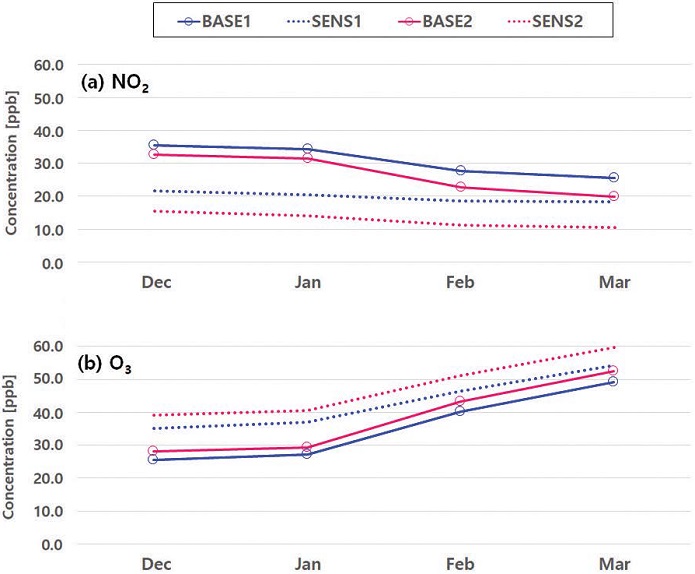
Monthly mean (a) NO2 and (b) O3 concentrations in the SMA during the simulation period of December 2019 to March 2020.
NOX 농도가 낮아진 Case 2 모사에서 수도권 경유차 배출에 의한 기간 평균 수도권 PM2.5 농도 영향은 1.3 μg/m3로, CAPSS 2016 배출량을 그대로 이용한 Case 1에 비해 0.5 μg/m3 증가하였다. 수도권 질산염 농도 영향은 0.0 μg/m3에서 0.4 μg/m3로 증가하였다 (그림 9). 지역별로 살펴보면 PM2.5 농도 영향은 Case 1에 비해 서울, 경기, 인천에서 각각 0.5, 0.5, 0.3 μg/m3 높아져 1.5, 1.2, 0.9 μg/m3로 증가하였으며 질산염 농도 영향 또한 0.3~0.4 μg/m3가량 증가하였다. 이는 앞서 언급한 Case 2 기본 모사에서 NOX 배출 감소로 O3 농도가 변화하여, 질산염 농도에 대한 영향이 증가하였기 때문으로, 수도권 경유차 배출 저감 효과가 NOX 배출 조건에 따라 달라짐을 의미한다. 즉, 다른 부문의 NOX 배출량 저감 노력이 병행되었을 때, 수도권 경유차 배출 저감이 PM2.5 농도 감소에 효과적임을 알 수 있다. 따라서 수도권과 같이 NOX 농도가 높은 지역의 경우 다양한 NOX 배출저감을 통해 PM2.5 농도 개선을 보다 효과적으로 이끌어 낼 수 있을 것으로 보인다.
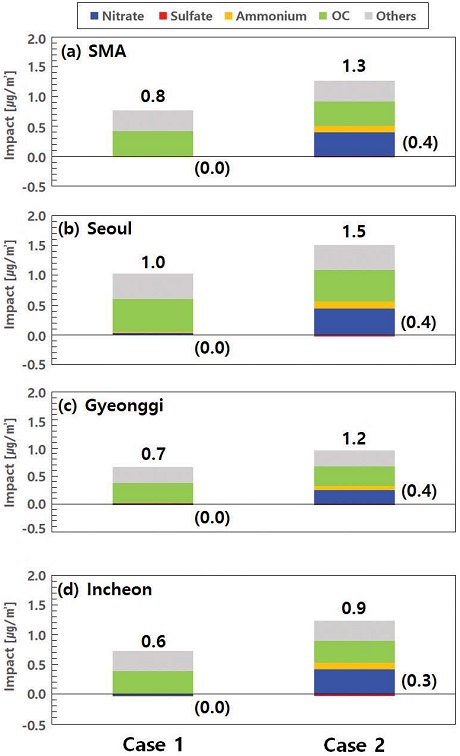
The period mean impact of diesel vehicle on PM2.5 components in (a) SMA, (b) Seoul, (c) Gyeonggi, and (d) Incheon from Case 1 (left) and Case 2 (right). The numbers in bracket represent the nitrate impact and the numbers represent the PM2.5 impact.
앞서 그림 8에서 설명한 바와 같이 BASE1과 BASE2의 기본 모사에 이용된 NOX 배출량은 차이를 보이나, 삭감된 배출량 (수도권 경유차)은 동일하다. 단위 NOX 배출량 (unit: million ton per year; MTPY) 감소에 따른 질산염 농도 개선 효과를 분석하기 위해 NOX 배출-농도 전환율 (NOX-to-nitrate 전환율=[기본 모사농도-민감도 모사농도]/삭감 배출량)을 계산하였다. 수도권 경유차 배출에 의한 NOX-to-nitrate 전환율은 수도권에서 -0.1 μg/m3/MTPY (CASE1)에서 2.6 μg/m3/MTPY (CASE2)로, 전반적인 NOX 농도 감소 조건에서 높다. 특히 서울과 인천에서의 해당 NOX-to-nitrate 전환율은 Case 1 (음수)에 비해 Case 2 (양수)에서 증가하였다 (표 6). 이는 수도권에서 NOX 배출 삭감에 의한 질산염 농도 감소를 기대하기 위해서는 일정 수준 이상의 NOX 배출 관리가 필요함을 의미한다. 또한, 계절관리제와 같이 여러 부문을 대상으로 하는 배출량 감축 정책의 효과를 분석하고자 하는 경우, 개별적인 배출원에 대해 다른 오염원의 배출 감소가 영향을 미칠 수 있기 때문에 이러한 특성을 고려하여, 개별적인 배출원에 대한 분석이 아닌 종합적인 분석이 중요하다.

NOX-to-nitrate conversion rates for the diesel vehicle emissions in the SMA under different NOX conditions during the period of December 2019~March 2020.
NOX-to-nitrate 전환율은 지역별, 계절별 차이를 보일 수 있으며, 배출원에 따라서도 달라진다 (Bae et al., 2020a; Ju et al., 2019; Kim et al., 2019; Kim et al., 2017c). 다른 연구들과 비교했을 때, NOX-to-nitrate 전환율은 기간, 지역, 계절, 배출원 등 다양한 조건이 상이하여 다르게 나타나나, 비슷한 조건에서 실험된 Kim et al. (2017c)와는 유사한 음 (negative)의 NOX-to-nitrate 전환율을 보였다 (표 S2).
4. 결 론
본 연구에서는 계절관리제가 시행된 2019년 12월~2020년 3월 사이 수도권 지역의 경유차 배출이 PM2.5 농도에 미치는 영향을 대기질 모사를 통해 분석하였다. 수도권 경유차 배출량 100% 감소 시 수도권의 PM2.5 모사농도는 계절관리제 기간 평균 0.8 μg/m3 감소하였으며, 이는 주로 PM2.5 성분 중 유기탄소와 기타 성분의 농도 감소에 의한 것으로 나타났다. 한편, 질산염의 경우 2019년 12월 및 2020년 1월에는 NOX-disbenefit으로 인해 오히려 농도가 증가하였다. 이러한 농도 변화는 1년 전 동일한 기간 (2018년 12월~2019년 3월)에 대한 대기질 모사 결과에서도 유사하게 나타나, 기상조건에 따른 차이는 작은 것으로 판단하였다.
계절관리제에서 경유차 배출량의 저감 이외에 다른 배출 부문에 대한 저감을 가정하고 있으므로, 도로이동오염원을 제외한 전국 모든 오염원의 NOX 배출량이 50% 삭감된 조건에서의 수도권 경유차 배출량의 저감 영향을 추가적으로 분석하였다. 이 경우 NOX-disbenefit 효과가 크게 감소하여 앞선 결과와는 달리 수도권 경유차의 NOX 배출량 감소가 질산염 농도의 감소로 이어졌다. 이는 배출량이 동일하게 저감되더라도 대기질 개선 정도는 대기화학 조건에 따라 달라질 수 있음을 의미한다. 또한, 개별 배출량 삭감에 대한 PM2.5와 같은 2차 대기오염물질의 농도 개선 효과 분석은 다양한 대책별 효과 분석과는 다를 수 있다. 따라서, 계절관리제와 같이 여러 배출부문을 대상으로 하는 배출량 저감대책의 경우, 배출 조건 변화를 고려한 종합적인 대기질 개선효과 분석이 필요하다.
다만, 본 연구에서는 2016년 국가 배출목록을 기반으로 수도권 경유차의 배출영향을 평가하였으며, 이는 실제 운행기반으로 산정되는 경유차 배출량 기반의 평가와는 차이를 보일 수 있다. 또한, 경유차의 도로운행에 따른 비산먼지 영향은 고려하지 못하였으며, 휘발성유기물질에 의한 유기탄소 영향 등을 산정하기 위해 향후 이에 대한 모사 재현성이 보완이 필요하다. 특히, 본 연구는 PM2.5 중량 농도 영향만을 살펴보았으나, 인체건강 측면에서 중요한 원소탄소 등 개별 물질별 평가 등 포괄적인 경유차 배출 영향에 대한 평가가 필요해 보인다.
Acknowledgments
본 연구는 국가미세먼지정보센터 지원 및 정부 (과학기술정보통신부, 환경부) 재원을 받은 한국연구재단-미세먼지 국가전략프로젝트사업 (2017M3D8A1092020 )의 일환으로 수행되었으며, 이에 감사를 드립니다.
References
-
Anenberg, S.C., Miller, J., Minjares, R., Du, L., Henze, D.K., Lacey, F., Malley, C.S., Emberson, L., Franco, V., Klimont, Z., Heyes, C. (2017) Impacts and mitigation of excess diesel-related NOX emissions in 11 major vehicle markets, Nature, 545(7655), 467-471.
[https://doi.org/10.1038/nature22086]

-
Bae, M., Yoo, C., Kim, S. (2020a) Estimating the Shutdown Effect of the Old Coal-fired Power Plants on PM2.5 and its Composition, Journal of Korean Society for Atmospheric Environment, 36(1), 48-63, (in Korean with English abstract).
[https://doi.org/10.5572/KOSAE.2020.36.1.048]

-
Bae, M., Kim, B.-U., Kim, H.C., Kim, S. (2020b) A Multiscale Tiered Approach to Quantify Contributions: A Case Study of PM2.5 in South Korea During 2010-2017, Atmosphere, 11(2), 141.
[https://doi.org/10.3390/atmos11020141]

-
Burr, M.J., Zhang, Y. (2011) Source apportionment of fine particulate matter over the Eastern U.S. Part I: source sensitivity simulations using CMAQ with the Brute Force method, Atmospheric Pollution Research, 2(3), 300-317.
[https://doi.org/10.5094/APR.2011.036]

-
Byun, D., Schere, K.L. (2006) Review of the Governing Equations, Computational Algorithms, and Other Components of the Models-3 Community Multiscale Air Quality(CMAQ) Modeling System, Applied Mechanics Reviews, 59(2), 51-77.
[https://doi.org/10.1115/1.2128636]

-
Cai, S., Ma, Q., Wang, S., Zhao, B., Brauer, M., Cohen, A., Martin, R.V., Zhang, Q., Li, Q., Wang, Y., Hao, J., Frostad, J., Forouzanfar, M.H., Burnett, R.T. (2018) Impact of air pollution control policies on future PM2.5 concentrations and their source contributions in China, Journal of Environmental Management, 227, 124-133.
[https://doi.org/10.1016/j.jenvman.2018.08.052]

- Carter, W.P.L. (2000) Implementation of the SAPRC-99 chemical mechanism in the models-3 framework.
-
Ding, A., Huang, X., Nie, W., Chi, X., Xu, Z., Zheng, L., Xu, Z., Xie, Y., Qi, X., Shen, Y., Sun, P., Wang, J., Wang, L., Sun, J., Yang, X.-Q., Qin, W., Zhang, X., Cheng, W., Liu, W., Pan, L., Fu, C. (2019a) Significant reduction of PM2.5 in eastern China due to regional-scale emission control: evidence from SORPES in 2011-2018, Atmospheric Chemistry and Physics, 19(18), 11791-11801.
[https://doi.org/10.5194/acp-19-11791-2019]

-
Ding, D., Xing, J., Wang, S., Liu, K., Hao, J. (2019b) Estimated Contributions of Emissions Controls, Meteorological Factors, Population Growth, and Changes in Baseline Mortality to Reductions in Ambient PM2.5 and PM2.5-Related Mortality in China, 2013-2017, Environmental Health Perspectives, 127(6), 67009.
[https://doi.org/10.1289/EHP4157]

-
Gentner, D.R., Jathar, S.H., Gordon, T.D., Bahreini, R., Day, D.A., El Haddad, I., Hayes, P.L., Pieber, S.M., Platt, S.M., de Gouw, J., Goldstein, A.H., Harley, R.A., Jimenez, J.L., Prevot, A.S., Robinson, A.L. (2017) Review of Urban Secondary Organic Aerosol Formation from Gasoline and Diesel Motor Vehicle Emissions, Environmental Science and Technology, 51(3), 1074-1093.
[https://doi.org/10.1021/acs.est.6b04509]

-
Ghim, Y.S., Choi, Y., Park, J., Kim, S., Bae, C.H., Seo, J., Shin, H.J., Lim, Y.J., Lyu, Y.S., Lee, Y.J. (2019) Overall Characteristics of Nationwide High PM2.5 Episodes during 2013~2016, Journal of Korean Society for Atmospheric Environment, 35(5), 609-624, (in Korean with English abstract).
[https://doi.org/10.5572/KOSAE.2019.35.5.609]

-
Guenther, A., Karl, T., Harley, P., Wiedinmyer, C., Palmer, P.I., Geron, C. (2006) Estimates of global terrestrial isoprene emissions using MEGAN(Model of Emissions of Gases and Aerosols from Nature), Atmospheric Chemistry and Physics, 6(11), 3181-3210.
[https://doi.org/10.5194/acp-6-3181-2006]

-
Heo, J.-B., Hopke, P.K., Yi, S.-M. (2009) Source apportionment of PM2.5 in Seoul, Korea. Atmospheric Chemistry and Physics, 9(14), 4957-4971.
[https://doi.org/10.5194/acp-9-4957-2009]

-
Holland, S.P., Mansur, E.T., Muller, N.Z., Yates, A.J. (2016) Damages and Expected Deaths Due to Excess NOX Emissions from 2009 to 2015 Volkswagen Diesel Vehicles, Environmental Science and Technology, 50(3), 1111-1117.
[https://doi.org/10.1021/acs.est.5b05190]

-
Hong, S.Y., Dudhia, J., Chen, S.H. (2004) A revised approach to ice microphysical processes for the bulk parameterization of clouds and precipitation, Monthly Weather Review, 132(1), 103-120.
[https://doi.org/10.1175/1520-0493(2004)132<0103:ARATIM>2.0.CO;2]

-
Hong, S.Y., Noh, Y., Dudhia, J. (2006) A new vertical diffusion package with an explicit treatment of entrainment processes, Monthly Weather Review, 134(9), 2318-2341.
[https://doi.org/10.1175/MWR3199.1]

-
Huang, X., Ding, A., Gao, J., Zheng, B., Zhou, D., Qi, X., Tang, R., Wang, J., Ren, C., Nie, W., Chi, X., Xu, Z., Chen, L., Li, Y., Che, F., Pang, N., Wang, H., Tong, D., Qin, W., Cheng, W., Liu, W., Fu, Q., Liu, B., Chai, F., Davis, S.J., Zhang, Q., He, K. (2020) Enhanced secondary pollution offset reduction of primary emissions during COVID-19 lockdown in China, National Science Review.
[https://doi.org/10.1093/nsr/nwaa137]

-
Huo, H., Zheng, B., Wang, M., Zhang, Q., He, K.B. (2015) Vehicular air pollutant emissions in China: evaluation of past control policies and future perspectives, Mitigation and Adaptation Strategies for Global Change, 20(5), 719-733.
[https://doi.org/10.1007/s11027-014-9613-0]

-
Iacono, M.J., Delamere, J.S., Mlawer, E.J., Shephard, M.W., Clough, S.A., Collins, W.D. (2008) Radiative forcing by longlived greenhouse gases: Calculations with the AER radiative transfer models, Journal of Geophysical Research Atmospheres, 113(13), 2-9.
[https://doi.org/10.1029/2008JD009944]

- International Agency for Research on Cancer (IARC) Working Group on the Evaluation of Carcinogenic Risks to Humans (2014) Diesel and Gasoline Engine Exhausts and Some Nitroarenes. IARC Monographs on the Evaluation of Carcinogenic Risks to Humans, 105, 9.
-
Jang, Y., Lee, Y., Kim, J., Kim, Y., Woo, J.H. (2019) Improvement China Point Source for Improving Bottom-Up Emission Inventory, Asia-Pacific Journal of Atmospheric Sciences, 56(1), 107-118.
[https://doi.org/10.1007/s13143-019-00115-y]

-
Ju, H., Yoo, C., Kim, B.-U., Kim, H.C., Kim, S. (2019) Impact of Stack Parameters on Modeled PM2.5 Conversion Rates: A Case Study of Chungnam during the KORUS-AQ 2016, Journal of Korean Society for Atmospheric Environment, 35(5), 593-608,(in Korean with English abstract).
[https://doi.org/10.5572/KOSAE.2019.35.5.593]

-
Jung, E.M., Kim, K.N., Park, H., Shin, H.H., Kim, H.S., Cho, S.J., Kim, S.T., Ha, E.H. (2020) Association between prenatal exposure to PM2.5 and the increased risk of specified infant mortality in South Korea, Environment International, 144, 105997.
[https://doi.org/10.1016/j.envint.2020.105997]

-
Kim, S., Moon, N., Byun, D.W. (2008) Korea Emissions Inventory Processing Using the US EPA’s SMOKE System, Asian Journal of Atmospheric Environment, 2(1), 34-46.
[https://doi.org/10.5572/ajae.2008.2.1.034]

-
Kim, E., Kim, B.-U., Kim, H., Kim, S. (2017a) The Variability of Ozone Sensitivity to Anthropogenic Emissions with Biogenic Emissions Modeled by MEGAN and BEIS3, Atmosphere, 8(12).
[https://doi.org/10.3390/atmos8100187]

-
Kim, S., Bae, C., Kim, B.-U., Kim, H.C. (2017b) PM2.5 Simulations for the Seoul Metropolitan Area: (I) Contributions of Precursor Emissions in the 2013 CAPSS Emissions Inventory, Journal of Korean Society for Atmospheric Environment, 33(2), 139-158, (in Korean with English abstract).
[https://doi.org/10.5572/KOSAE.2017.33.2.139]

-
Kim, S., Bae, C., Yoo, C., Kim, B.-U., Kim, H.C., Moon, N. (2017c) PM2.5 Simulations for the Seoul Metropolitan Area: (II) Estimation of Self-Contributions and Emission to-PM2.5 Conversion Rates for Each Source Category, Journal of Korean Society for Atmospheric Environment, 33(4), 377-392, (in Korean with English abstract).
[https://doi.org/10.5572/KOSAE.2017.33.4.377]

-
Kim, E., Bae, C., Yoo, C., Kim, B.-U., Kim, H.C., Kim, S. (2018) Evaluation of the Effectiveness of Emission Control Measures to Improve PM2.5 Concentration in South Korea, Journal of Korean Society for Atmospheric Environment, 34(3), 469-485, (in Korean with English abstract).
[https://doi.org/10.5572/KOSAE.2018.34.3.469]

-
Kim, E., Kim, H.C., Kim, B.-U., Kim, S. (2019) PM2.5 Simulations for the Seoul Metropolitan Area: (VI) Estimating Influence of Sectoral Emissions from Chungcheongnam-do, Journal of Korean Society for Atmospheric Environment, 35(2), 226-248, (in Korean with English abstract).
[https://doi.org/10.5572/KOSAE.2019.35.2.226]

-
Kim, E., Kim, B.-U., Kim, H.C., Kim, S. (2021) Direct and cross impacts of upwind emission control on downwind PM2.5 under various NH3 conditions in Northeast Asia, Environmental Pollution, 268, 115794.
[https://doi.org/10.1016/j.envpol.2020.115794]

-
Kwon, H.Y., Jung, C.H., Kim, Y.P. (2016) The Impact of Local Government’s Expenditure on Air Quality in Korea, Journal of Korean Society for Atmospheric Environment, 32(6), 583-592, (in Korean with English abstract).
[https://doi.org/10.5572/KOSAE.2016.32.6.583]

-
Lee, K.S., Lim, Y.H., Choi, Y.J., Kim, S., Bae, H.J., Han, C., Lee, Y.A., Hong, Y.C. (2020) Prenatal exposure to traffic-related air pollution and risk of congenital diseases in South Korea, Environmental Research, 191, 110060.
[https://doi.org/10.1016/j.envres.2020.110060]

-
Li, Q., Zhang, L., Wang, T., Wang, Z., Fu, X., Zhang, Q. (2018) “New” Reactive Nitrogen Chemistry Reshapes the Relationship of Ozone to Its Precursors, Environmental Science and Technology, 52(5), 2810-2818.
[https://doi.org/10.1021/acs.est.7b05771]

- Ministry Of Environment (MOE) (2020) https://me.go.kr/, (Accessed on Dec 1, 2020).
-
Nam, K., Lee, H., Lee, J., Park, H., Choi, J., Lee, D. (2019). A Study on the Method of Calculation of Domestic and Foreign Contribution on PM2.5 using Brute-Force Method, Journal of Korean Society for Atmospheric Environment, 35(1), 86-96, (in Korean with English abstract).
[https://doi.org/10.5572/KOSAE.2019.35.1.086]

- National Centers for Environmental Prediction (NCEP) (2000) NCEP FNL Operational Model Global Tropospheric Analyses, continuing from July 1999, Research Data Archive at the National Center for Atmospheric Research, Computational and Information Systems Laboratory.
- National Institute of Environmental Research (NIER) (2019) National Air Pollutants Emission 2016.
-
Schlesinger, R.B. (2007) The Health Impact of Common Inorganic Components of Fine Particulate Matter (PM2.5) in Ambient Air: A Critical Review, Inhalation Toxicology, 19(10), 811-832.
[https://doi.org/10.1080/08958370701402382]

- Seinfeld, J.H., Pandis, S.N. (2016) Atmospheric chemistry and physics: from air pollution to climate change, John Wiley & Sons, 29-31.
-
Shin, D.C. (2013) The Domestic Research Trend and the Road Map of Health Risk Assessment of the Air Quality in Korea, Journal of Korean Society for Atmospheric Environment, 29(5), 528-535, (in Korean with English abstract).
[https://doi.org/10.5572/KOSAE.2013.29.5.528]

-
Skamarock, W.C., Klemp, J.B. (2008) A time-split nonhydrostatic atmospheric model for weather research and forecasting applications, Journal of Computational Physics, 227(7), 3465-3485.
[https://doi.org/10.1016/j.jcp.2007.01.037]

-
Son, K., Bae, M., You, S., Kim, E., Kang, Y.-H., Bae, C., Kim, Y., Kim, H.C., Kim, B.-U., Kim, S. (2020) Meteorological and Emission Influences on PM2.5 Concentration in South Korea during the Seasonal Management: A Case of December 2019 to March 2020, Journal of Korean Society for Atmospheric Environment, 36(4), 442-463, (in Korean with English abstract).
[https://doi.org/10.5572/KOSAE.2020.36.4.442]

-
Yeo, M.J., Kim, Y.P. (2019) Trends of the PM10 Concentrations and High PM10 Concentration Cases in Korea, Journal of Korean Society for Atmospheric Environment, 35(2), 249-264, (in Korean with English abstract).
[https://doi.org/10.5572/KOSAE.2019.35.2.249]

Appendix
SUPPLEMENTARY MATERIALS
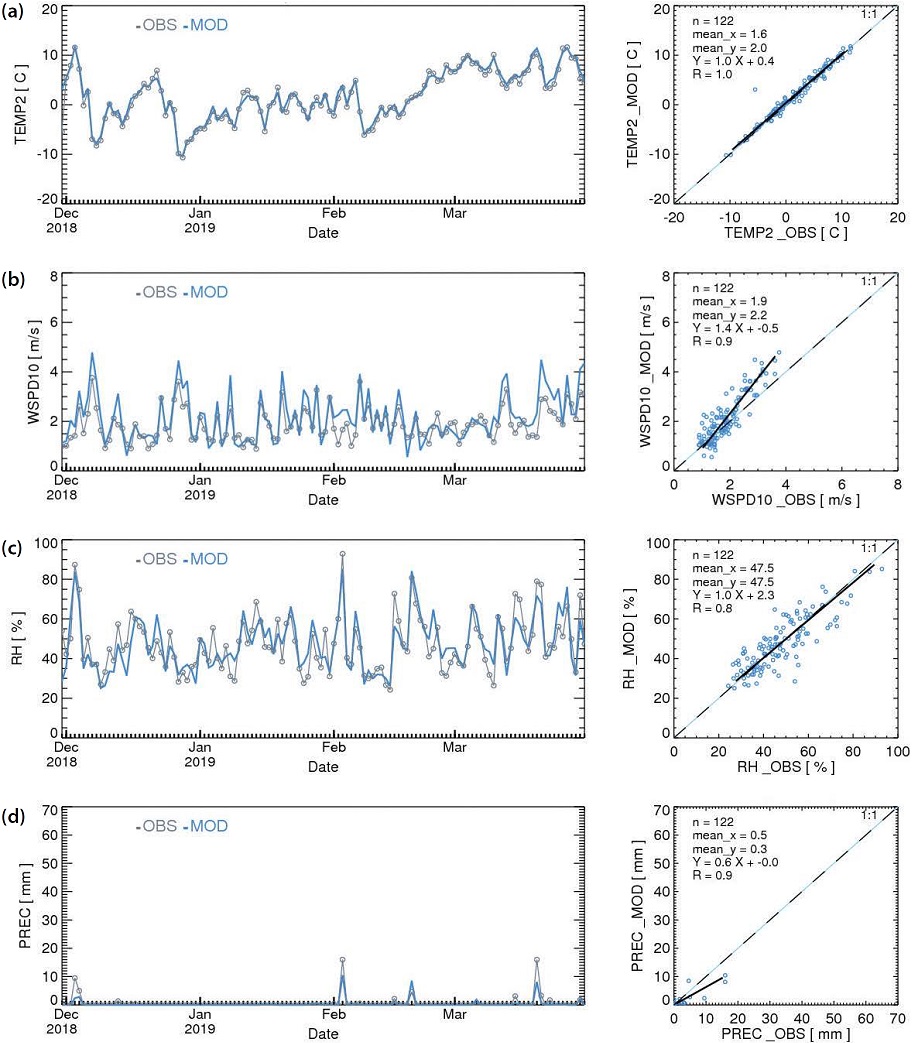
The time series and scatters of observed and simulated daily mean (a) 2-m temperature, (b) 10-m wind speed, (c) relative humidity, and (d) precipitation at the Seoul weather station during the simulation period of December 2018 to March 2019.

Time series and scatters of daily averages of the observed and simulated (a) PM2.5, (b) O3, (c) NO2, and (d) SO2 concentrations in the SMA from December 2018 to March 2019.

The impact of diesel vehicles on PM2.5 concentrations during the 2018 simulation period. (unit: μg/m3)
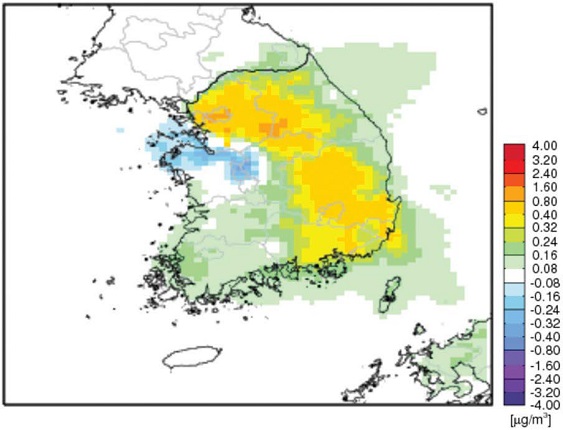
Impact of the SMA diesel vehicle emissions on the period mean PM2.5 concentration during the period of December 2018 to March 2019.
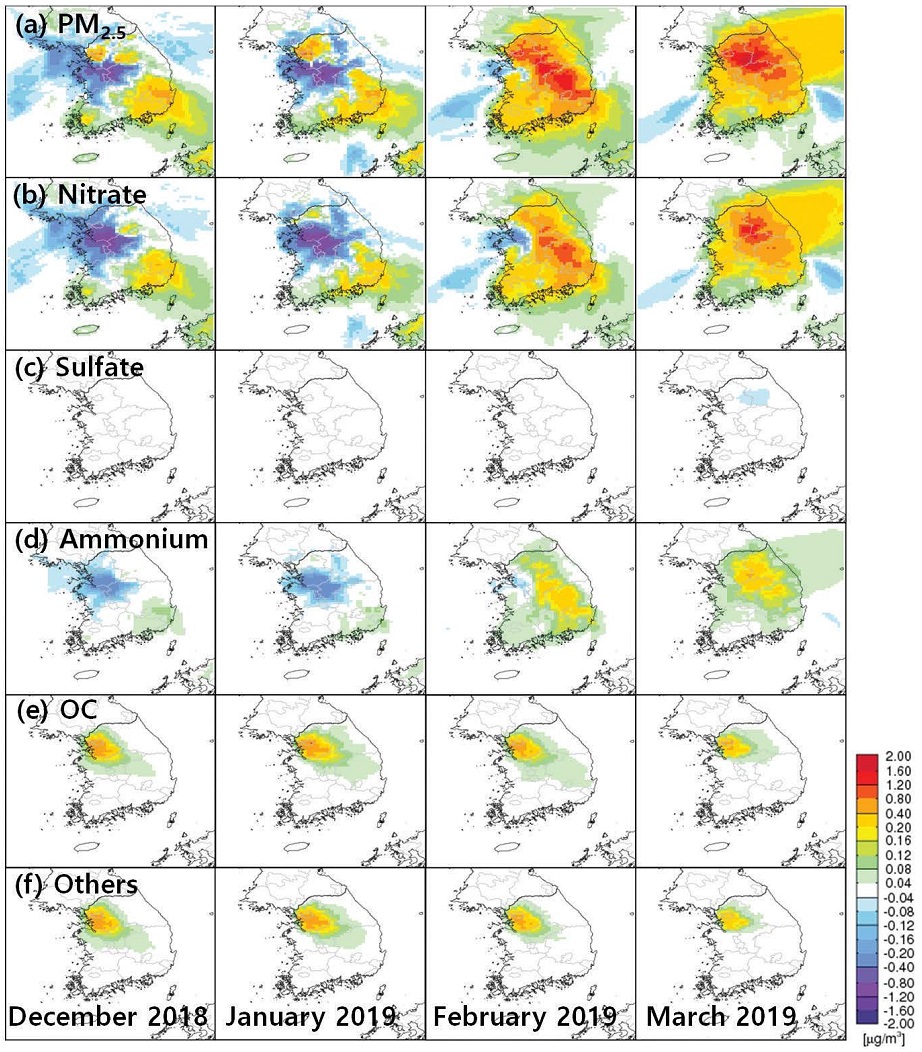
Impact of the SMA diesel vehicle emissions on monthly mean PM2.5 concentrations and its components during the simulation period of December 2018 to March 2019.
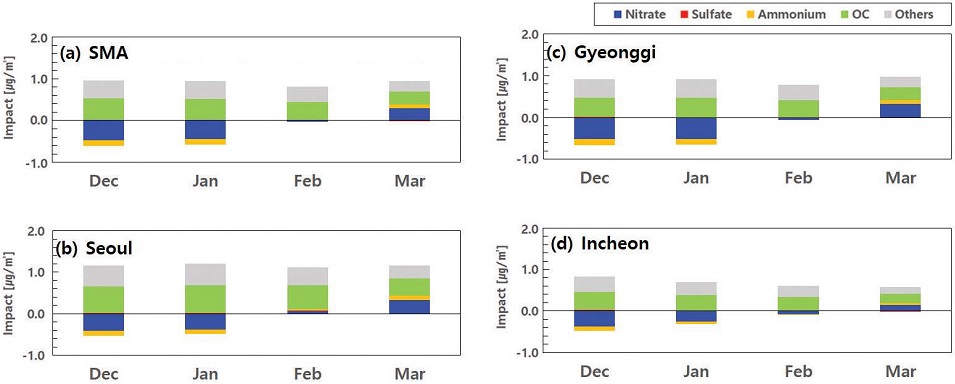
Impacts of the SMA diesel vehicle emissions on the monthly mean PM2.5 components in (a) the SMA, (b) Seoul, (c) Gyeonggi, and (d) Incheon during simulation period of December 2018 to March 2019.
김윤하 (아주대학교 환경연구소 연구원)
김은혜 (아주대학교 환경안전공학과 강사)
강윤희 (아주대학교 환경연구소 연구조교수)
유승희 (아주대학교 환경공학과 박사과정)
배민아 (아주대학교 환경공학과 박사과정)
손규원 (아주대학교 환경공학과 석사과정)
김순태 (아주대학교 환경안전공학과 교수)
